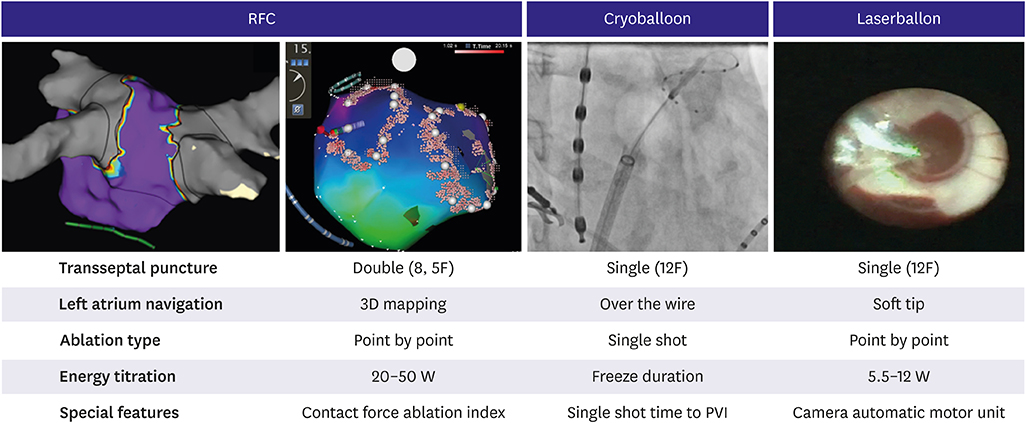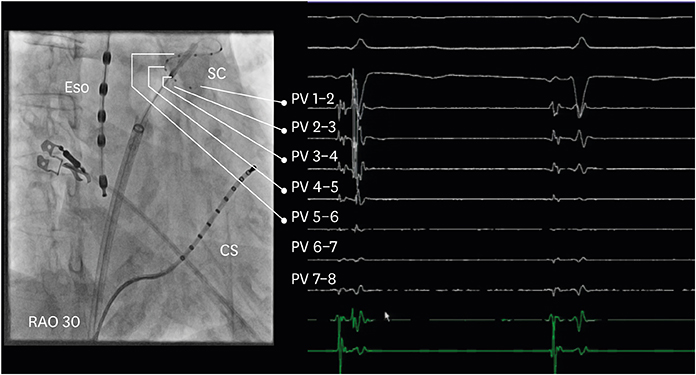Korean Circ J.
2019 Nov;49(11):991-1001. 10.4070/kcj.2019.0226.
Current Status of Atrial Fibrillation Ablation with Balloon Strategy
- Affiliations
-
- 1Medizinische Klinik III, CCB Kardiologie, Agaplesion Markus Krankenhaus, Frankfurt am Main, Germany. j.chun@ccb.de
- KMID: 2460523
- DOI: http://doi.org/10.4070/kcj.2019.0226
Abstract
- Catheter ablation of atrial fibrillation (AF) has been established worldwide and is recommended for symptomatic paroxysmal AF patients according to international guidelines. Importantly, the cornerstone of any AF ablation represents pulmonary vein isolation (PVI). Traditional radiofrequency (RF) point by point ablation within a 3D electroanatomic left atrial (LA) map requires profound understanding of LA anatomy and electrophysiology. This ablation strategy can be highly efficient and safe if performed in experienced hands and centers. However, procedural complexity causes a long learning curve and has limited its wide spread utilization. In contrast, balloon based PVI ablation strategies are based on an anatomic principle. Currently, two balloon types (cryoballoon and laserballoon) have been adopted to clinical routine. Both balloons are positioned at the target PV and circumferential energy ablation is enabled. This simplified anatomic approach facilitates reaching the procedural endpoint of PVI and demonstrated less operator dependency. Therefore, balloon PVI appears to be associated with improved procedural reproducibility and safety. Importantly, large scale randomized trials proved non-inferiority of balloon guided AF ablation (cryothermal and laser energy) vs. experienced operators using traditional "gold standard" RF ablation in paroxysmal and persistent AF. Ongoing technological refinements of both balloons as well as the introduction of novel energy dosing strategies and ablation targets may potentially impact the current way of ablating AF in future. This review will summarize current clinical experience of contemporary balloon devices and will look into future developments.
MeSH Terms
Figure
Reference
-
1. Krijthe BP, Kunst A, Benjamin EJ, et al. Projections on the number of individuals with atrial fibrillation in the European Union, from 2000 to 2060. Eur Heart J. 2013; 34:2746–2751.
Article2. Kirchhof P, Benussi S, Kotecha D, et al. 2016 ESC Guidelines for the management of atrial fibrillation developed in collaboration with EACTS. Eur Heart J. 2016; 37:2893–2962.3. Haïssaguerre M, Jaïs P, Shah DC, et al. Spontaneous initiation of atrial fibrillation by ectopic beats originating in the pulmonary veins. N Engl J Med. 1998; 339:659–666.
Article4. Ouyang F, Bänsch D, Ernst S, et al. Complete isolation of left atrium surrounding the pulmonary veins: new insights from the double-Lasso technique in paroxysmal atrial fibrillation. Circulation. 2004; 110:2090–2096.5. Reddy VY, Dukkipati SR, Neuzil P, et al. Randomized, controlled trial of the safety and effectiveness of a contact force-sensing irrigated catheter for ablation of paroxysmal atrial fibrillation: results of the TactiCath Contact Force Ablation Catheter Study for Atrial Fibrillation (TOCCASTAR) study. Circulation. 2015; 132:907–915.6. Natale A, Reddy VY, Monir G, et al. Paroxysmal AF catheter ablation with a contact force sensing catheter: results of the prospective, multicenter SMART-AF trial. J Am Coll Cardiol. 2014; 64:647–656.7. Packer DL, Mark DB, Robb RA, et al. Effect of catheter ablation vs antiarrhythmic drug therapy on mortality, stroke, bleeding, and cardiac arrest among patients with atrial fibrillation: the CABANA randomized clinical trial. JAMA. 2019; 321:1261–1274.8. Mark DB, Anstrom KJ, Sheng S, et al. Effect of catheter ablation vs medical therapy on quality of life among patients with atrial fibrillation: the CABANA randomized clinical trial. JAMA. 2019; 321:1275–1285.9. Marrouche NF, Brachmann J, Andresen D, et al. Catheter ablation for atrial fibrillation with heart failure. N Engl J Med. 2018; 378:417–427.
Article10. Providencia R, Defaye P, Lambiase PD, et al. Results from a multicentre comparison of cryoballoon vs. radiofrequency ablation for paroxysmal atrial fibrillation: is cryoablation more reproducible? Europace. 2017; 19:48–57.
Article11. Perrotta L, Bordignon S, Dugo D, Fürnkranz A, Chun KJ, Schmidt B. How to learn pulmonary vein isolation with a novel ablation device: learning curve effects using the endoscopic ablation system. J Cardiovasc Electrophysiol. 2014; 25:1293–1298.
Article12. Chun KR, Schmidt B, Metzner A, et al. The ‘single big cryoballoon’ technique for acute pulmonary vein isolation in patients with paroxysmal atrial fibrillation: a prospective observational single centre study. Eur Heart J. 2009; 30:699–709.
Article13. Nagase T, Bordignon S, Perrotta L, et al. Analysis of procedural data of pulmonary vein isolation for atrial fibrillation with the second-generation laser balloon. Pacing Clin Electrophysiol. 2019; 42:837–845.
Article14. Kuck KH, Brugada J, Fürnkranz A, et al. Cryoballoon or radiofrequency ablation for paroxysmal atrial fibrillation. N Engl J Med. 2016; 374:2235–2245.
Article15. Kuck KH, Fürnkranz A, Chun KR, et al. Cryoballoon or radiofrequency ablation for symptomatic paroxysmal atrial fibrillation: reintervention, rehospitalization, and quality-of-life outcomes in the FIRE AND ICE trial. Eur Heart J. 2016; 37:2858–2865.
Article16. Fürnkranz A, Bordignon S, Schmidt B, et al. Improved procedural efficacy of pulmonary vein isolation using the novel second-generation cryoballoon. J Cardiovasc Electrophysiol. 2013; 24:492–497.
Article17. Straube F, Dorwarth U, Vogt J, et al. Differences of two cryoballoon generations: insights from the prospective multicentre, multinational FREEZE Cohort Substudy. Europace. 2014; 16:1434–1442.
Article18. Fürnkranz A, Bordignon S, Dugo D, et al. Improved 1-year clinical success rate of pulmonary vein isolation with the second-generation cryoballoon in patients with paroxysmal atrial fibrillation. J Cardiovasc Electrophysiol. 2014; 25:840–844.
Article19. Giovanni GD, Wauters K, Chierchia GB, et al. One-year follow-up after single procedure Cryoballoon ablation: a comparison between the first and second generation balloon. J Cardiovasc Electrophysiol. 2014; 25:834–839.
Article20. Martins RP, Hamon D, Césari O, et al. Safety and efficacy of a second-generation cryoballoon in the ablation of paroxysmal atrial fibrillation. Heart Rhythm. 2014; 11:386–393.
Article21. Metzner A, Reissmann B, Rausch P, et al. One-year clinical outcome after pulmonary vein isolation using the second-generation 28-mm cryoballoon. Circ Arrhythm Electrophysiol. 2014; 7:288–292.
Article22. Reddy VY, Sediva L, Petru J, et al. Durability of pulmonary vein isolation with cryoballoon ablation: results from the Sustained PV Isolation with Arctic Front Advance (SUPIR) study. J Cardiovasc Electrophysiol. 2015; 26:493–500.
Article23. Bordignon S, Fürnkranz A, Perrotta L, et al. High rate of durable pulmonary vein isolation after second-generation cryoballoon ablation: analysis of repeat procedures. Europace. 2015; 17:725–731.
Article24. Wissner E, Metzner A, Reissmann B, et al. Wide circumferential versus individual isolation of pulmonary veins using the endoscopic ablation system. J Cardiovasc Electrophysiol. 2014; 25:253–258.
Article25. Dukkipati SR, Neuzil P, Kautzner J, et al. The durability of pulmonary vein isolation using the visually guided laser balloon catheter: multicenter results of pulmonary vein remapping studies. Heart Rhythm. 2012; 9:919–925.
Article26. Dukkipati SR, Cuoco F, Kutinsky I, et al. Pulmonary vein isolation using the visually guided laser balloon: a prospective, multicenter, and randomized comparison to standard radiofrequency ablation. J Am Coll Cardiol. 2015; 66:1350–1360.27. Bordignon S, Chun KR, Gunawardene M, et al. Comparison of balloon catheter ablation technologies for pulmonary vein isolation: the laser versus cryo study. J Cardiovasc Electrophysiol. 2013; 24:987–994.
Article28. Verma A, Jiang CY, Betts TR, et al. Approaches to catheter ablation for persistent atrial fibrillation. N Engl J Med. 2015; 372:1812–1822.
Article29. Koektuerk B, Yorgun H, Hengeoez O, et al. Cryoballoon ablation for pulmonary vein isolation in patients with persistent atrial fibrillation: one-year outcome using second generation cryoballoon. Circ Arrhythm Electrophysiol. 2015; 8:1073–1079.30. Boveda S, Metzner A, Nguyen DQ, et al. Single-procedure outcomes and quality-of-life improvement 12 months post-cryoballoon ablation in persistent atrial fibrillation: results from the multicenter CRYO4PERSISTENT AF trial. JACC Clin Electrophysiol. 2018; 4:1440–1447.31. Bordignon S, Boehmer MC, Klostermann A, et al. Visually guided pulmonary vein isolation in patients with persistent atrial fibrillation. Europace. 2016; 18:538–542.
Article32. Schmidt B, Neuzil P, Luik A, et al. Laser balloon or wide-area circumferential irrigated radiofrequency ablation for persistent atrial fibrillation: a multicenter prospective randomized study. Circ Arrhythm Electrophysiol. 2017; 10:e005767.
Article33. Aryana A, Baker JH, Espinosa Ginic MA, et al. Posterior wall isolation using the cryoballoon in conjunction with pulmonary vein ablation is superior to pulmonary vein isolation alone in patients with persistent atrial fibrillation: a multicenter experience. Heart Rhythm. 2018; 15:1121–1129.
Article34. Kuniss M, Greiß H, Pajitnev D, et al. Cryoballoon ablation of persistent atrial fibrillation: feasibility and safety of left atrial roof ablation with generation of conduction block in addition to antral pulmonary vein isolation. Europace. 2017; 19:1109–1115.
Article35. Di Biase L, Burkhardt JD, Mohanty P, et al. Left atrial appendage: an underrecognized trigger site of atrial fibrillation. Circulation. 2010; 122:109–118.36. Di Biase L, Burkhardt JD, Mohanty P, et al. Left atrial appendage isolation in patients with longstanding persistent AF undergoing catheter ablation: BELIEF Trial. J Am Coll Cardiol. 2016; 68:1929–1940.37. Bordignon S, Chen S, Perrotta L, et al. Durability of cryoballoon left atrial appendage isolation: acute and invasive remapping electrophysiological findings. Pacing Clin Electrophysiol. 2019; 42:646–654.
Article38. Gadiyaram VK, Mohanty S, Gianni C, et al. Thromboembolic events and need for anticoagulation therapy following left atrial appendage occlusion in patients with electrical isolation of the appendage. J Cardiovasc Electrophysiol. 2019; 30:511–516.
Article39. Zender N, Weise FK, Bordignon S, et al. Thromboembolism after electrical isolation of the left atrial appendage: a new indication for interventional closure? Europace. 2019.
Article40. Metzner A, Wissner E, Schoonderwoerd B, et al. The influence of varying energy settings on efficacy and safety of endoscopic pulmonary vein isolation. Heart Rhythm. 2012; 9:1380–1385.
Article41. Chun KR, Fürnkranz A, Metzner A, et al. Cryoballoon pulmonary vein isolation with real-time recordings from the pulmonary veins. J Cardiovasc Electrophysiol. 2009; 20:1203–1210.
Article42. Dorwarth U, Schmidt M, Wankerl M, Krieg J, Straube F, Hoffmann E. Pulmonary vein electrophysiology during cryoballoon ablation as a predictor for procedural success. J Interv Card Electrophysiol. 2011; 32:205–211.
Article43. De Regibus V, Abugattas JP, Iacopino S, et al. Single freeze per vein strategy with the second-generation cryoballoon for atrial fibrillation: a propensity score-matched study between 180- and 240-s application time in a large cohort of patients. Europace. 2018; 20:f377–83.
Article44. Aryana A, Kenigsberg DN, Kowalski M, et al. Verification of a novel atrial fibrillation cryoablation dosing algorithm guided by time-to-pulmonary vein isolation: Results from the Cryo-DOSING Study (Cryoballoon-ablation DOSING Based on the Assessment of Time-to-Effect and Pulmonary Vein Isolation Guidance). Heart Rhythm. 2017; 14:1319–1325.
Article45. Chen S, Schmidt B, Bordignon S, Perrotta L, Bologna F, Chun KR. Impact of cryoballoon freeze duration on long-term durability of pulmonary vein isolation: ICE Re-Map study. JACC Clin Electrophysiol. 2019; 5:551–559.46. Hoffmann E, Straube F, Wegscheider K, et al. Outcomes of cryoballoon or radiofrequency ablation in symptomatic paroxysmal or persistent atrial fibrillation. Europace. 2019.47. Maltoni S, Negro A, Camerlingo MD, et al. Comparison of cryoballoon and radiofrequency ablation techniques for atrial fibrillation: a meta-analysis. J Cardiovasc Med (Hagerstown). 2018; 19:725–738.48. Chun KR, Perrotta L, Bordignon S, et al. Complications in catheter ablation of atrial fibrillation in 3,000 consecutive procedures: balloon versus radiofrequency current ablation. JACC Clin Electrophysiol. 2017; 3:154–161.49. Fürnkranz A, Bordignon S, Böhmig M, et al. Reduced incidence of esophageal lesions by luminal esophageal temperature-guided second-generation cryoballoon ablation. Heart Rhythm. 2015; 12:268–274.
Article50. Packer DL, Kowal RC, Wheelan KR, et al. Cryoballoon ablation of pulmonary veins for paroxysmal atrial fibrillation: first results of the North American Arctic Front (STOP AF) pivotal trial. J Am Coll Cardiol. 2013; 61:1713–1723.51. Franceschi F, Dubuc M, Guerra PG, et al. Diaphragmatic electromyography during cryoballoon ablation: a novel concept in the prevention of phrenic nerve palsy. Heart Rhythm. 2011; 8:885–891.
Article52. Ghosh J, Sepahpour A, Chan KH, Singarayar S, McGuire MA. Immediate balloon deflation for prevention of persistent phrenic nerve palsy during pulmonary vein isolation by balloon cryoablation. Heart Rhythm. 2013; 10:646–652.
Article53. Nagase T, Bordignon S, Perrotta L, et al. Low risk of pulmonary vein stenosis after contemporary atrial fibrillation ablation - lessons from repeat procedures after radiofrequency current, cryoballoon, and laser balloon. Circ J. 2018; 82:1558–1565.
- Full Text Links
- Actions
-
Cited
- CITED
-
- Close
- Share
- Similar articles
-
- The Mechanism of and Preventive Therapy for Stroke in Patients with Atrial Fibrillation
- Controlled Atrial Fibrillation after Pulmonary Vein Stenting
- A Case of Successful Ablation of Right-Sided Accessory Pathway during Atrial Fibrillation
- A Totally Thoracoscopic Ablation for Persistent Atrial Fibrillation
- Large Circular Ring Catheter Ablation Versus Anatomically Guided Ablation of Atrial Fibrillation: Back to the Future for Successful Catheter Ablation of Atrial Fibrillation?




